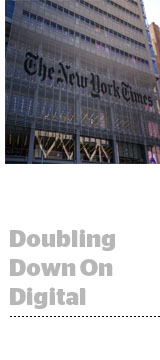
The New York Times is making good on its goal to rev digital subscription revenue, but not at the expense of its other key growth driver: digital advertising.
The Times’ total subscription revenue surpassed $1 billion in 2017 as the company added 157,000 net new, digital-only subscriptions in Q4, it announced during its Q4 earnings call Thursday.
That figure represents a striking annual growth rate of 46% for pure digital subs, to $340 million. Subscriptions now account for 60% of the Times’ total revenue.
But the Times’ efforts to drive more recurring revenue through subscription didn’t overshadow its digital advertising business, which saw double-digit percentage growth to $238 million in 2017.
The company closed the year with more than $607 million in total digital revenue, including subscriptions, digital advertising and other digital products, such as Wirecutter.
The New York Times’ president and CEO, Mark Thompson, pointed to the company’s 2017 results as evidence of the demand in-market for “trusted, quality journalism,” particularly at a time when platform companies are being pushed to weed out fake news.
“If the market ever doubted whether there was a strong need for quality journalism, the big changes we’ve seen over the last couple of years at digital platforms [like Facebook and Google] as well as consumer subscriptions shows that differentiated, high-quality news is really valuable,” Thompson said during the earnings call.
With Facebook revealing plans to pare down on organic content from publishers – an ongoing move to prioritize content from friends and family over brands and publishers in the news feed – many publishers were understandably concerned.
But The New York Times predicts that change could bode well for premium publishers in the long term.
“We haven’t seen many changes yet on Facebook, but long-term, we do think there will be more need for news [sources] that are destination- and relationship-based,” Meredith Kopit Levien, EVP and COO, said during the call. “The ability to direct people’s attention to news that matters at scale is a compelling proposition in the market right now.”
This post was syndicated from Ad Exchanger.

More Stories
Trifecta for OMD at Cannes Young Lions 2024
Ogilvy Names Rafael Rizuto Chief Creative Officer for North America
NZME podcast Sex.Life hits 1 million downloads